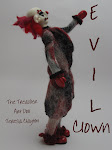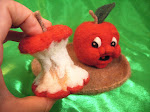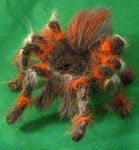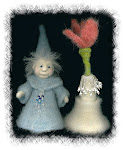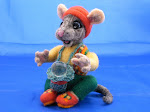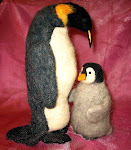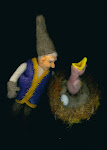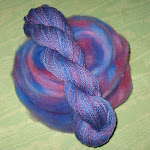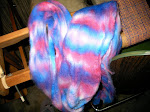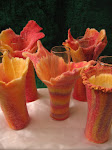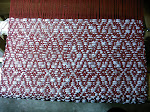This posting will not be a tutorial. There is no method to the madness here. In my last post I demonstrated how to twist a nice length of prepared wool top into a compact and manageable braid without dividing the fibers into three strips. That happy braiding process is the starting point of this most evil experiment.
Aren't they lovely? Five fantastic, 4 oz braids from a commercially combed wool/mohair blend. The mohair adds a touch of luster that is going to really make those acid dyes pop!
First we condition the fibers, make them comfortable. I've prepared a warm soak with just a touch of Synthrapol to encourage our unsuspecting fibers to be receptive to the dye treatment.
(Again, this is an evil experiment. Measurements are made in pinches, dashes and dollops.)
The braided fibers are left to relax and soak in the warm, sudsy water.
Evil ensues, I have plucked one of the braids from the bath. I do not want these fibers to be sopping wet so I gently squeeze out much of the soaking solution and arrange the braid on the (slab) operating table.
HOLY COW! I bet you didn't see that coming. (Heh.) Reminds me of television, when I'm watching a happy, little show about apple orchards or bunnies and suddenly some crazy CSI commercial appears out-of-nowhere with the blood and the guts and the gruesomeness... No warning... No time to shut my eyes or flip the channel...
So, what is
in the syringe? I started out with a nice splash of a 1% dye stock solution. I love Sabraset/Lanaset dyes. They are oh so very light and color fast (won't fade) and wonderfully vibrant. To each of my dye cups I add a bit of
chemical water: sodium acetate and citric acid crystals. Amounts? (Heh, heh.) Here I must point you to the voice of sanity. This book is a must for the serious fiber artist who loves to dye wool:
Color In Spinning by Deb Menz. You will thank me for not handing you the answers. By the way I have nothing to gain by referring you here. This book is a joy and a necessity. The woman dedicated 10 years of her life to perfecting the
truly scientific process of dying wool. It is not for me to deny you this experience by tossing out crazy, irrelevant measurements that are herein only loosely based in reality.
I just have to say, if all the world were addicted to the textile arts then bubble gum trading cards would include super heros of the fiber world and Deb Menz would definitely have her own card. (For my money a Deb Menz card, in mint condition, at a well advertised auction would glean several thousand dollars.)
I have much more to say on this topic of collectible, super hero, fiber artist, trading cards...And not to be dropping names but, I'd want to be sure my personal trading card collection included an Alden Amos, a Mabel Ross, an Elizabeth Zimmermann and a Peter Teal...but I digress. (That's O.K. because I'm in scary, mad scientist mode.) And, this is what we have after several more injections:
And, here we see the patient has been flipped over in preparation for more treatments.

And, after further injections...
Who's the mad scientist now?
I think this experiment has all the earmarks of a successful operation. But, as the old saying goes, "No brain no pain." Strike that. I mean to say, "No pain no gain." Whichever, it's time to bring on the heat!
After all, acid dyes are heat-set dyes. I'm going to use a microwave. (Yay.) And, although I am a mad scientist I'm not crazy. The microwave I use in all of my evil dye experiments is never, never, I repeat NeVeR used for heating food that one might put in one's mouth and eat. (For that matter none of the tools pictured will ever be used for food processing. Go to a thrift store and thusly recycle what you need for your own wonderfully evil dye lab.)
Above: Here we see the colorful braid "entombed" in a microwavable roasting tupper. This was an unusually special thrift store find at $2.50. (If there were tight-wad, thrifty-person trading cards I would be my own hero. And, my trading card would be worth several tens of dollars - for insurance purposes only .)
And here's my $5.00, thrift store, 200 lb wool-dying microwave from sometime before the turn of the century (when things were built to last, thank you very much). It has simmer mode. And now we wait?
And, now we wait.








